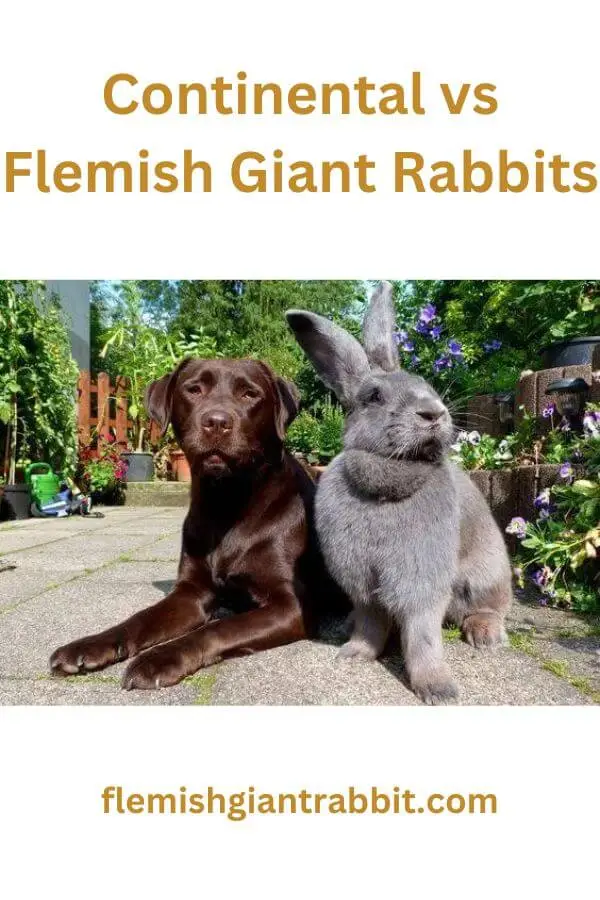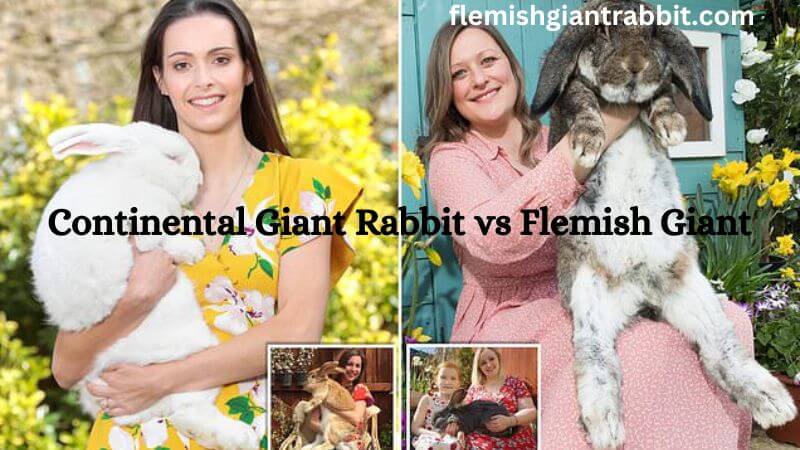Continental giant rabbits and Flemish giants are one of the largest rabbit breeds in the world. With similar features that make it difficult to identify one from the other. However, within my 25 years as a vet, I have handled these giant breeds and mastered the key differences and unique features they share.

I guess your curiosity made you insert “continental giant rabbit vs Flemish giant” in your search bar. You’re on the right site! In this article, you will discover amazing things about continental giant rabbits and Flemish giants. And their differences! In the end, you will be able to identify these giant breeds at a glance.
How Do Continental Giant Rabbit and Flemish Giant Look Alike?
Continental giant rabbits and Flemish giant rabbits have identical features that may even get you confused about their differences. Both giant breeds have strong, heavy bones with a muscular build at their hind region.
They also have long, wide heads, and portrayed ears; with thick, stuffy fur coating. However, Flemish giants have fur-covered skin that is not as dense as the continental giants.
Moreso, Flemish giants, and continental giants are both gentle and easily tamed. Their owners can train them to learn and understand different gestures and commands.
Continental Giant Rabbit Vs Flemish Giant: Unique Differences
The unique differences that exist between continental giant rabbits and Flemish giants lie in their body size, physical appearance, and overall behavior. We will explain that in detail!
Continental Giant Rabbit Vs Flemish Giant: Physical Appearance.
Continental giant rabbit has a large head with a cube-like build. They also have broad shoulder ends, with ears that have round tips and widen on the inside. The Flemish giant has a thinner head shape with a pointy snout and ears as short as 6 inches. But spiny at its tips so that it looks like a pointed ear.
Continental giant rabbit and the Flemish giant breed have thick fur. But Flemish giants have a fur coating that is less dense when compared with continental giants. Continental giant rabbit has a very heavy fur coating that has different colors. Which are white and colored. The colored coats can be black, yellow, or grey. A look at their skin will make you think they were covered with a double coat of fur. The coat is compact with a soft hair-like pad underneath which often needs trimming.
However, Flemish giant rabbits have a slick, shiny fur coating that doesn’t always need trimming. Their fur color varies from black to white, blue, grey, or fawn. The slick, glossy coat of Flemish giant rabbits will help you identify them once you see them. Continental giant rabbits do not have such skin coating.
Continental Giant Rabbit Vs Flemish Giant: Overall Body Size
The height of a continental giant rabbit is approximately 3 feet! With its size weighing within the range of 16 to 20 pounds. Their back region has a well-muscled build with hind legs and ears as long as one-fourth of its body length. Their average lifespan is 5 years.
In contrast, Flemish giant rabbits have the size of an average dog with a body size weighing up to 22 pounds. And even more, as they have a high tendency of becoming overweight over time. They also have huge muscles and their rear region and hind legs with a partially curved body. An average Flemish giant rabbit can live as long as 5 to 7 years.
Continental Giant Vs. Flemish Giant Rabbit: Behaviour
The continental giant rabbit is cool-headed, gentle, and easy to tame. They are so intelligent that they can be trained to understand and obey different commands. They are energetic and love to play and roam around, due to their somewhat smaller size when compared to Flemish giants. Also, they enjoy having quiet moments with their owners. From my experience with them, I discovered that they do not like their feet to be touched.
On the other hand, Flemish giant rabbits love to be carried and cuddled. They are more relaxed when held and tend to be less active due to their huge size. They are also very gentle and patient unless threatened. Flemish giant rabbits are clever and can be trained to learn the meaning of human gestures and commands.
Common Health Problems
There are several health problems associated with the huge size of this giant breed. You should take note of this if you want to adopt any of them as pets. They are detailed below!
- Sore Hocks: giant rabbits exert their weight on their toes while sitting or standing. This puts so much pressure on the hocks! An Average-sized rabbit may not develop any health problems because of this. But giant breeds like Continental giant rabbits and Flemish giants tend to develop sores beneath their toes. Due to prolonged pressure on the toes! Sore hocks isa bacterial infections that are associated with skin inflammation and redness, blood-filled wounds, and loss of fur. Factors like the use of plastic or metallic wires on the floor of your rabbit’s house can worsen the problem! Take your rabbit to a vet once you notice they find it difficult and painful to walk.
- Obesity: Continental giant rabbits and Flemish giants can become overweight due to the accumulation of excess body fat. Obesity comes with other issues like heart problems, inactivity, and many more. This is why you must focus on feeding timothy hay to your rabbits and reduce the ingestion of high-calorie foods. Also, ensure these giant rabbits exercise a lot.

Frequently Asked Questions Related To Continental Giant Rabbits Vs. Flemish Giant
Do Giant Rabbits Make Good Pets?
Yes! But they may not be the best for some people. Flemish giant and continental giant rabbits are gentle, friendly, and unlikeable. They can easily bond with children and other family pets. But, they can be harsh when threatened or frightened. They can even bite! And their bites are piercing and painful. We advise you to oversee how they mingle with children.
Which Giant Rabbit Breed Is Best For Me?
These giant breeds are good family pets. You can adopt any of them; either Flemish giant or continental giant rabbits. Both are gentle and tameable animals that can turn out to be your best companions. Nonetheless, you must know that Flemish giants are associated with several health problems due to their huge size. They tend to get overweight over time and inactive too! As regards these, we recommend you go for continental giants. Moreover, continental giants have very thick fur coating that requires frequent trimming and hygiene. If you are not ready for constant trimming and cleaning of this furry fellow, you can go for Flemish giant rabbits.
What Is The Best Housing Option For These Giant Rabbits?
Because of the huge size of these rabbit breeds, we recommend you buy at least a hutch of 6 feet in length, 2 feet in height, and 2 feet in depth. Considering the different sizes of Flemish giant and Continental giant rabbits, this living space may not even be enough for them. The bottom line is that you ensure you provide enough living space that allows your rabbits to stand freely and stretch out without wall-like restrictions. You can also provide a sizable bed cave for them inside your house.
Which Food Can I Give To These Rabbits?
Always provide fiber-rich foods like hay, and grasses for these giant breeds, If you have them as pets. 80% of their diet should contain hay and grasses, while vegetables, fruits, and pellets should make up the remaining 20%. This is to ensure healthy living for your furry friends.
How Much Food Can A Giant Rabbit Eat?
Giant rabbits like Flemish giants and continental giants need a larger amount of food, unlike their smaller fellows due to their huge size. When serving them food, triple the amount of food an average-sized rabbit can eat. Of course, they need it because of their size. One water bowl can be enough for a typical rabbit but cannot satisfy the thirst of these giant breeds. Always provide a good number of clean water sources. Continental giant rabbits Flemish Giants should not be allowed to be dehydrated for long; it comes with adverse health effects.
More so, we advise you to limit the amount and frequency of treats you serve to them. Treats like carrots and other fruit that are high in sugar and carbs should be given at least thrice a month. Continental giant rabbit and Flemish giant are already huge. And do not need foods that can add to their body weight!
Do Continental Giant Rabbits and Flemish Giants Need Exercise?
Yes! Just like small rabbit breeds need a lot of physical activity, giant rabbits like continental giant rabbits and Flemish giants need it even more. Exercise helps them to burn excess fat they don’t need. This helps to boost their health and physical fitness. Allowing them to stay quiet in a place for a prolonged period is capable of making them accumulate fatter and become overweight!
Can A Giant Rabbit Pet Live Alone?
Naturally, rabbits are social beings and love to live in groups, just like their wild fellows. They may feel bored and lonely, staying on their own. We know it may be difficult to have more than one giant rabbit as a pet. But we recommend we adopt a pair. So, they socialize and snuggle into each other for warmth and comfort.
Conclusion
I believe you have known the identical features and differences between the continental giant rabbit and the Flemish giant. And you can easily identify them at a glance. Both giant breeds can be good companions and family pets. But, because of their huge size, they need a large living space and an ample amount of food. If you can cater to their needs, you may adopt any of them, either continental giant rabbits or Flemish giants.